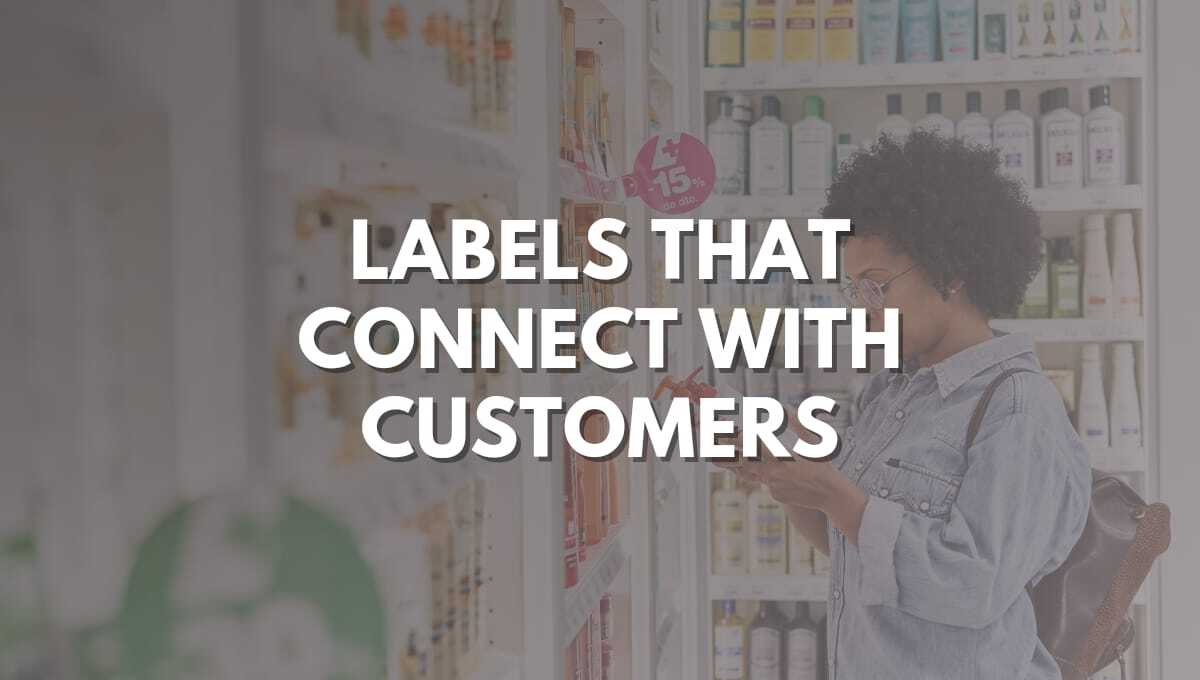Labels That Tell Stories: How to Use Labels to Connect with Customers on a Deeper Level

Customers are bored with traditional and boring product labels. They don't want to read another generic label that keeps telling them about the product's benefits. Then what should you do?
The ideal solution to this is Telling Stories.
You can connect with potential buyers through stories and evoke emotions in them. Storytelling is an undeniably amazing marketing tool that works like a charm. However, not many companies know how to utilize it in their favor. Your brand's story should motivate people to purchase the product. You should tell the story across all customer touchpoints, such as email, website, labels, and social media.
Humans are highly focused on visual aspects. They convey meaning and emotions indirectly through colors and images. You're not using a single word but telling an interesting story that keeps the audience hooked. That's why carefully crafted product labels and packaging are crucial for success.
In this article, we'll provide you with the best guide on how to make labels that tell stories to clear up all the confusion. So, keep reading to learn more.
What Is Storytelling In Product Labels

Source: solveoco
Storytelling in marketing means creating a narrative that connects with customers emotionally, making your brand memorable and meaningful. You can convert a boring product into a cherished item with a compelling story. Your aim should be to improve the overall customer experience. Let's understand with an example.
Suppose two companies sell organic honey products. They may be selling the same thing, but they may be using different labels.
Company A is using it with storytelling tactics and stating.
"Our honey comes from bees that collect nectar from wildflowers in the Rocky Mountains. Each jar is carefully harvested by hand, giving you these beautiful flowers' pure, natural taste."
Meanwhile, the company B label is boring and simply states the benefits.
"Organic Honey: 100% pure and raw. No additives or preservatives."
Customers' experiences will vary. Storytelling in product labels has several benefits, some of which are listed below.
- Emotional Engagement: Stories evoke joy, nostalgia, and empathy. Thus making the brand more relatable and memorable.
- Enhanced Brand Identity: A well-crafted story communicates the brand's values, mission, and vision. It enhances identity and differentiation in the market.
- Customer Loyalty: Emotional connections built through storytelling. It leads to increased customer loyalty and advocacy.
Elements of a Story-Driven Label
Making a story-driven label is challenging. You need to be consistent, and it takes research. If you do it the right way, then at some point, customers will instantly recognize your brand colors, fonts, styles, and even the imagery you use. That's why you must incorporate all three elements properly in the labels. Let's look at how you can do it.
Core Narrative Components
The first and most basic elements you should add to your labels are core narrative components. Here are some of them.
Characters
Characters include the founders, employees, customers, or even imaginary figures or mascots. One of the biggest examples is the Duolingo mascot. These characters help humanize the brand and make the story relatable.
In Asian countries, most bakeries and cafes have their own mascots. You can use them on your labels and excite consumers about your product.
Setting
Always add settings to your product labels. But what does that mean?
It means telling where your product is made and sharing the environment from which ingredients are sourced. Let's understand with an example.
A coffee brand may highlight its beans and their unique taste, further stating that they are sourced from a specific region in Colombia.
Plot
A plot is a unique sequence of events or the product's journey. it includes
History of brand → Creation process → Impact on community
And the list of these plots goes on. A skincare brand can use this to tell how they made unique formulas from rare botanical extracts.
Visual Elements

Source: othernetwork
People don't just read. They scan. They scan visual elements instead of reading paragraphs. You can provide clear and concise information using these visual elements.
Imagery
Always use high-quality images and illustrations. Cheap images mean you're not serious about selling and don't care about customers. Images can convey parts of the story without a word.
But how?
If you're selling dairy products, the label might show illustrations of the farm where dairy cows are raised. Likewise, images can vary depending on your product.
Typography
Font matters a lot. Your font can influence the tone and readability of the label. That's why luxury products use elegant serif fonts. Meanwhile, a playful, artisanal product might use hand-drawn or script fonts.
You should identify where your company stands and then choose a font that describes your business.
- Luxury Items: Often use black, gold, or silver to convey elegance and exclusivity.
- Eco-Friendly Products: Frequently use green and brown to emphasize their natural and sustainable qualities.
- Children's Products: Bright, playful colors like red, yellow, and blue are used to appeal to kids and parents.
Color Schemes
Color psychology is of great importance and has psychological impacts on people. That's why every brand uses unique color schemes for its products.
Pepsi has two primary colors: blue and red. Blue conveys trust and reliability, while red adds a sense of excitement and energy. So, what will happen when you combine blue and red in product labels?
It creates a dynamic and appealing look. Thus promoting Pepsi as a refreshing and dependable choice.
Textual Elements
Now, let's look at the most obvious factor of a story-driven label: adding textual elements. Here are some of them.
Taglines & Slogans
Many brands have seen incredible success because of their unique slogans and taglines. It tells about the brand story in a few words.
For example, L'Oréal's "Because You're Worth It" slogan is powerful. It gives a message of self-worth and empowers customers.

Source: linkedin
Brief Stories or Anecdotes
It's another unique storytelling factor in your label. It adds brief stories or anecdotes to the labels. It should give a glimpse of either the brand's history or the product's creation.
Every time customers buy your product, they'll be excited and curious about the brief note they'll get.
Product Origins / Maker's Story
Share the journey of how the product was made. It adds a personal touch to the product. For example, "Handcrafted in small batches in Vermont" adds authenticity. It tells that the company is dedicated to providing the best product to the
Designing Labels that Tell a Story
You should first understand your brand story. That's how you'll be able to make a label that'll yield the best results. Let's look at some of the crucial aspects that are often ignored in this regard.
Identify Brand's Unique Story
Every brand has a unique story that sets it apart from others. Ask yourself, what is your brand story? What are you doing differently from your competitors?
It can be the journey of your founder, who faced many failures but remained resilient. Think beyond that, and you might be able to find a unique brand story in the inspiration behind your product or sustainability values. Identifying this core narrative is important in making unique labels that grab the attention of your audience.
Align Story with Brand Values & Mission
Your label story should reflect the brand's values and missions. It shouldn't be contradictory; otherwise, your company's reputation can be damaged. A contradictory story gives the impression that you're confused about your business, which isn't good. So, ensure alignment because it indicates authenticity and transparency.
Target Audience Analysis
Is target audience analysis really important?
It helps create a story that resonates with your target audience. Suppose your target audience is teenagers, but your story is in the tone of millennials. Will your target audience understand you?
Yes, they might understand it. However, it will not resonate with them, and they might not purchase from your brand.
That's why you should understand your target audience and know about their
- Demographics (age, gender, income, education)
- Psychographics (lifestyle, values, interests)
Customizing The Story
Now that you know about your target audience, it's time to move to the next step: crafting your story. Your story should appeal to your target audience and speak in their language.
Find out what sort of story appeals to your audience. Is it innovative? Fun? Entertaining? Motivational? Traditional?
Brainstorm all the ideas and, after research, finalize your story.
Consistency With Branding
The biggest mistake brands make when creating labels is not maintaining consistency. Your label should be consistent with the overall brand visual identity, which includes logos, color schemes, and fonts. But why is consistency important?
It reinforces brand recognition and trust. People can instantly recognize your product because of consistent branding.
To Sum Up
By now, you already know that storytelling goes beyond providing information to customers. It's a method of creating an emotional bond with consumers. This fosters customer loyalty and makes your product stand out even in a competitive market.
Many brands are now using storytelling techniques in their label design. It's a way to connect with customers, but staying updated with the latest trends is crucial. Do you still have any questions about taking your product labels to the next level?
Then, reach out to our team of experts today. We are here to assist you with your labeling needs and help you skyrocket your business growth.
